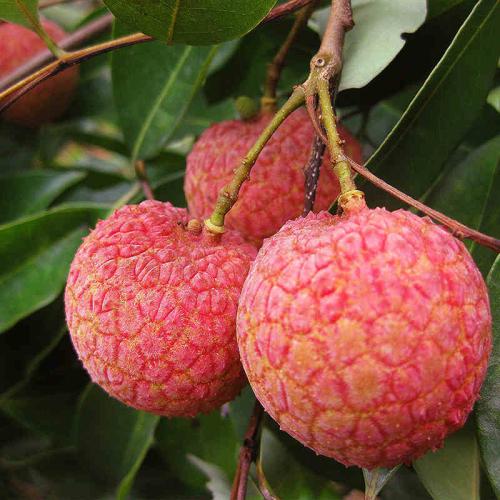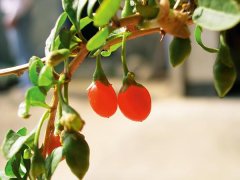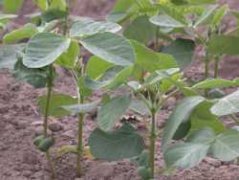Introduction of common diseases and control methods of litchi trees, and effects of litchi diseases on litchi trees
Do you grow lychees? If you have planting, you must pay attention to the diseases and insect pests of litchi. Let's take a look at the common diseases of litchi.
I. dew blight
Caused by Phytophthora infestans (Peronophythora litchi), it can harm flower organs, leaves, tender stems and fruit, but fruit is the most common; in overcast and rainy season, irregular browning spots appear on the fruit shell near the ground or where branches and leaves are dense, and there are dense gray-white powdery bacteria on them, and the diameter of the spot can often reach more than half of the fruit, and the diseased fruit will seriously drop fruit. After the weather clears up, the bacteria on the diseased fruit of the hanging tree will disappear, but it has lost its commercial value, which is one of the biggest causes of litchi fruit loss, especially in the continuous rainy season, the pathogen with flagella on the disease spot can be quickly spread to other fruits or other litchi plants by water droplets. according to reports, these walkers can invade the fruit epidermis in only 5 minutes. After 48 hours, cysts can be produced in the fruit epidermis to release the wandering seeds, resulting in a greater spread of infection. However, in case of dryness, the pathogen on the fruit surface will die and cannot spread, so the pandemic can only occur after continuous overcast and rain for many days. During the period of packing, transportation and sale, the fruit harvested in the overcast and rainy period will also have exposure blight, resulting in losses.
Prevention and control methods: refer to the plant protection manual before the rainy season to use fungicides such as Fosai Quadning, Zinc and Manganese Kejie or Quadening to prevent and cure, in order to avoid drug damage, do not apply under the high temperature of the sun. Early use of 1000 times of potassium hydroxide mixed with phosphorous acid can also increase the disease resistance of litchi.
Brown root disease
The pathogen is Phellinus noxius. More than 130 species of basidiomycetes have been known in Taiwan, including many forest trees, street trees and fruit trees. The disease is the most serious disease of litchi at present. the diseased plant can be divided into chronic wilting type and standing withered type. the former tree is weak, the leaves are sparse, yellow and thin, and wither after 1-2 years of disease. the standing withered type withered the whole plant about 1 week after sagging and discoloration of branches and leaves. The base of the plant and part of the thick root turned black, and the xylem at the base of the stem browned when the bark was peeled off. If the xylem died for a long time, the xylem was white and mixed brown lines, and there may be yellowish brown bacteria outside the bark.
Prevention and control methods: at present, no appropriate control agents are recommended, and barrier ditches should be set up between diseased plants and healthy plants to avoid root contact transmission; more alkaline organic fertilizer can reduce the activity of pathogens and reduce infection.
3. Acid rot
The pathogens were Geotrichum candidum and G. luddwigii, which caused fruit pericarp browning, yogurt-like milky mucus and sour odor. In overcast and rainy season, the spread of Rain Water spatter could cause most fruits to occur rapidly, and milky white bacteria could still exist for a period of time after rain stopped, which could be different from exposure blight. Small animals such as fruit flies, ants or snails can be used as vectors.
Prevention and control methods: there is no recommended medicament available. Attention should be paid to the management of moisture during the fruit period to reduce the occurrence of fruit cracking, and to control fruit flies to reduce the chance of infection and transmission of bacteria.
IV. Swollen leaf disease
Litchi rust (Eriophyes lichii), commonly known as hairy spider and hairy tick, caused fluffy protuberances in young leaves, inflorescences and young fruit epidermis, accumulated thickening and browning, and the damaged parts were transformed and curled, especially on the lower leaves of young leaves.

- Prev

When is the dormancy / flowering / fruiting period of medlar? When the temperature of Chinese wolfberry exceeds, it will go dormant.
The most commonly used medicinal part of Chinese wolfberry is the fruit, which is often called Chinese wolfberry, while the production and cultivation of Chinese wolfberry is almost concentrated in China, but only a small amount is cultivated in Taiwan at present. The prospect of planting Chinese wolfberry is still good. Chinese wolfberry: sesame oil chicken, ginger duck, etc.
- Next

How about Tainan No. 1, a new variety of edamame beans in Taiwan? Advantages of Taitai Nan Xuan No.1 in Golden Taro
Do you know the new variety of edamame bean, Dai Nan Xuan No.1? This variety of soybean is different from other soybeans, and it is also different from lentil planting. Let's take a look at it. Maodou Tainan Xuan No. 1 from Tainan District Agricultural improvement Farm and Asian vegetable Research
Related
- The first cup of black tea in spring, the flavor and history of tea gardens in Kenya, Africa
- The computer can not only choose potatoes, but also grow tea rice. AI will grow winter oolong tea champion.
- It is not only the inflated tea bitten by insects, but also engraved with the four seasons tea in Beipu.
- The Oriental Beauty Tea Festival in Zhuxian County takes the stage at the weekend to experience the plus-size feast of oil tea.
- & quot; Oriental Beauty Tea & Exploration of Emei in Hsinchu, the hometown of quot;
- The new variety of strawberry "Tainong 1" dessert is the first choice with mellow aroma. Crimson gorgeous
- History of Tea in Taiwan: from Wild Inner Mountain to Export Tea Garden
- Two types of Taiwan Oriental Beauty Black Tea won the British three-Star Award for Childhood Tea Xiang Zhang Jiaqi changed from pilot to champion tea maker.
- Banana species and varieties: the planting history of Taiwan Xianren banana and dwarf banana is long, is banana disease resistant?
- Coffee planting Technology: Qianjie Coffee from Seedling to harvesting

